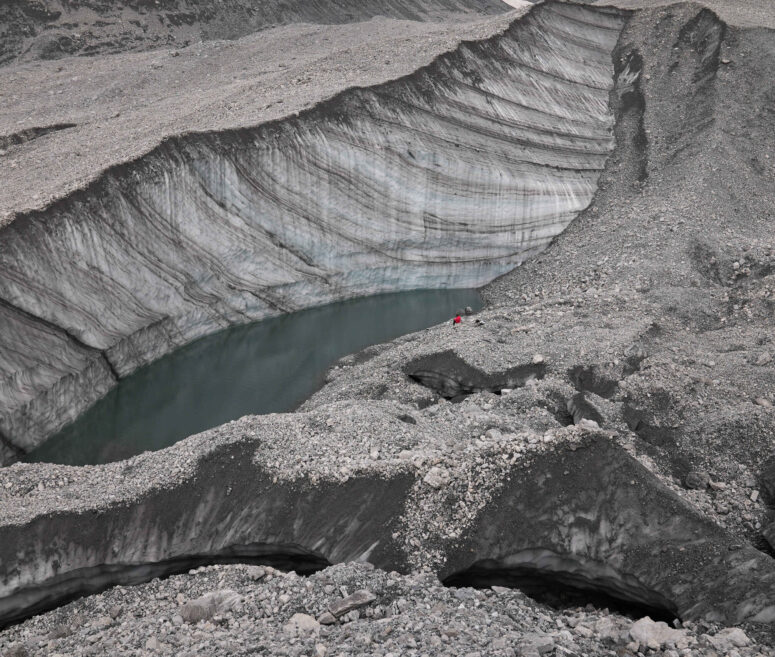Cara Montagna is not simply an act of restitution. It is a way of thinking and talking to the mountains, of establishing a correspondence in which language intertwines with the sounds and silences of the landscape. No longer just a letter sent awaiting a reply, but a continuous flow of resonances—of a storm, of the crackling of melting ice, of the slow breaking of water on the edge of a lake. It is a listening that reminds us that the “landscape” is a living body, in constant interaction with our own.
In recent years, listening to glaciers has become one of the most evocative and ambiguous practices of our relationship with the landscape. Microphones lowered into the cavities of the ice record fractures, dripping, melting: a living material that transforms, but also the sound document of a disappearance. As Lia Mazzari, an artist and researcher who has long explored the possibilities of expanded environmental listening, observes, “the history of environmental sound is the history of capture”: a gesture of appropriation that has often translated nature into an archive, reducing its complexity to a “sound treasure” to be preserved. Today, thanks to live audio streaming technologies, it is possible to listen with and not just listen from outside.
Cara Montagna (Dear Mountain) is a podcast produced by Ilaria Gadenz, created with Valentina Gervasoni.
ILARIA GADENZ
I would like to start from your most recent project. You just came back from the Alps where you installed a live listening station on top of a glacier. Tell me about it!
LIA MAZZARI
I have just literally just returned from the Dolomites, where I installed two live audio streams that listen continuously to the environment of the End der Welt Ferner glacier, at the base of the Ortles, inside the Stelvio National Park, close to the Swiss border.
From now onwards – now that I finally, with the help of others, of course, managed to install them there – we are planning to just keep this live audio stream running for as long as we can, for the next few months, hopefully years.
I’m already listening to it now, and it is probably the most dramatic soundscape I have ever heard, also because I had never really listened to a glacial environment before. I mean, I am a practitioner in sound, and of course we all have access to recordings of ice and the Arctic, but it was really the first time I had this experience of working in this kind of environment and also now basically listening to it continuously.
ILARIA GADENZ
You said as long as we can. Does it depend on the obsolescence of the technology, or when do you decide to switch off the streaming?
LIA MAZZARI
That’s a really nice question. I think in this particular case, it wouldn’t be me or us deciding to stop recording (and technically it is not recording but broadcasting, streaming, transmitting, whatever you want to call it), it would rather be the mountain deciding, because I have never worked in such an unstable environment, which actually asks the question, why would you do that in the first place?
The summer season has literally just started and that means that the glaciers are starting to move a lot. The snow is gone and the ice is melting, and the moraines, which are the loose sediment that lies really heavily on top of the glacier, keep just moving around. So, I didn’t realize it until I was there, but the floor just moves to such a large degree that the whole landscape looks different every day.
And therefore, we are trying to keep it there as long as we can, meaning it could be totally swallowed up by the mountain itself, which would be a real shame, but it’s a possibility. And also it just means weather, for example, extreme weather. We have had already in the last two weeks such heavy wind and rain that it just either goes offline, or the microphones just really don’t like this kind of environment, or I presume that in the winter it will get really cold, like it will go to minus 25 and it will snow a lot, so it could just be that it will be snowed in completely.
ILARIA GADENZ
So, I’ll cut to the chase: why do you do that in the first place?
LIA MAZZARI
To be honest, in this case, it was not really my decision. It was the community that lives there that asked me to do it. This year is the international year of the glaciers, or of the preservation of the glaciers announced by the UN, and therefore, since they’re living at the foot of this glacier that they’ve been observing for decades, they were thinking of wanting to listen to it through a live audio broadcast, and so approached me.
Since I started doing this research into live audio streaming, I also learned how some places are just off limits or how I have started to not want to stream from certain locations. But in this case, because of the invitation, I thought it could be really interesting to do it, especially because it’s also where I’m from. I am from Alto Adige, and I have lived more than half of my life not there anymore.
ILARIA GADENZ
Tell me what you mean by live audio streaming, because I’m also very interested in what you said about the decision not to stream from certain locations.
LIA MAZZARI
I use the term real-time listening or also, as I’ve done previously, listening with live audio streams to describe this act of listening to different kinds of environments via live audio transmission. And different from other ways of engaging with the sounds of our environments, such as what field recording practices do, in live audio streaming or transmitting, we always listen remotely via a digital live audio broadcast.
And this sonic liveness of the stream is afforded always by a connection to a server on the internet that then connects listeners from across the globe into a digitally shared soundscape. And in the practice of live audio streaming, we install microphones in a specific place. This can be natural or urban, hard to reach, really remote places… permanently or semi-permanently.
And from there, these microphones transmit the sound continuously from their location onto the internet. So imagine, for example, how through the streams it becomes suddenly possible to tune into the dawn chorus in Jakarta or a thunderstorm on Adler Mountain or an underwater microphone inside the Amstel Canal in the city center of Amsterdam or an industrial drone blasting from a data center in the outskirts of Dublin. And all of this then unfolding live in real time.
And this often invokes in its listeners a feeling or a sense of unpredictability or a feeling of urgency and just not knowing what comes next, which is caused by this collapse of spatial and temporal distance.
And that makes me – the listener – feel rooted and focused or attentive to this unstable moment of the present that is unfolding sonically over there. So it can be an activating and a grounding practice at the same time. And the more I spend time with these streams or keep listening with them, the more I feel like the listening becomes almost a form of witnessing, like an ecological or material witnessing to the things that might otherwise stay unheard or just unseen, overheard, maybe even silenced.
ILARIA GADENZ
What kind of artistic or scientific practice does it belong to in terms of tradition, what’s the history of live audio streaming?
LIA MAZZARI
Live audio streaming, it’s really important to mention that, is sustained through a variety of informally and openly shared methods and DIY practices. And these are constantly developed, innovated and changed by a very devoted and growing global community of artists, researchers, citizen scientists, scientists, of course, journalists, activists and educators of all kinds. So I don’t think we can particularly prescribe it to a specific kind of person that uses it. I think it’s open for anyone to use.
Personally, I’m interested not just in figuring out how they work, but also how these particular live practices can challenge and subvert outdated concepts and outdated views of our environment. But if you want to go more into the history, early transmission media such as telegraphs, telephones, radio, they were always a source of fascination and experimentation for artists working with sound. So artists like Alvin Lucier, John Cage, Max Neuhaus and Pauline Oliveros definitely made use of these materials.
But I think most notably one has to mention an incredible sound artist, composer and artist called Marianne Amacher. I think she’s really the godmother of live audio streaming or live audio transmitting, she called it remote listening. She had already created large scale sound installations that employed exactly these technologies in the 1960s with a decades-long project entitled City Links.
From 1967 to 1981 she did this incredible project, where she installed multiple open microphones all across different cities in the US, in locations such as harbors and highways and industrial zones that were undergoing some big development changes. And the way she did it was by getting the phone company to open up dedicated phone lines, where on one end she had a microphone and the other end was basically just led or fed into her studio in New York.
And this way she was able to listen 24-7 to the open mics and was just able to witness the sonic changes or how the soundscapes were unfolding.
She then used these streams or these transmissions in radio broadcasts, but also in live performances. I think she also installed them in different buildings, as sound installations and so on.
ILARIA GADENZ
I go back to what you said about the DIY ethos and openly shared methods behind live audio streaming. It seems to me that the ecological thinking and awareness you mentioned goes hand in hand with a political reclaim of the internet, as a collective, as a common.
What do you think about it?
LIA MAZZARI
Yeah, I totally agree with you. I mean, maybe I wasn’t aware of it in the beginning or I didn’t think about it so much, but I definitely felt it when I was part of the first live audio streaming event. The attraction of it was in that community aspect, that it is openly shared, that anyone can do it. And over all these years, trying to learn more about it and work with it, I have met so many incredible people that listen online to environments continuously.
But it’s also true what you said about this, that it is kind of a way to reclaim the internet as a space of freedom or a space that we want to inscribe and not the other way around.
This is what I am trying to learn in the upcoming years as well, how I can use live audio streams for discussions on environmental, political and material realities. I mean, people are already doing it so much, using these practices as critical listening practices. Like the citizen science projects where we use live audio streams to just listen to animal populations communally, in an openly shared way where everyone has access, not as a way to just capture a lot of data, right? Because we all have to remember that nothing is recorded. I mean, everything could be recorded, but that is up to the beholder of whoever is listening.
So they’re just there in the moment and then they disappear, which is very beautiful as well. But I think also what is important is that while live audio streaming technologies are shaped by their material components and extensive energy flows and we need to acknowledge that they also exist alongside neoliberal practices and media landscapes, their communities and the networks really actively work to always foster a critical engagement and relationality and make these practices investigative. So always aimed at understanding the ongoing transformation of geographies, more than human geographies or situations.
ILARIA GADENZ
You anticipated one of my questions about the sustainability of recording.
I was thinking of the gargantuan amount of data that such practices might produce but this contrasts with the idea of listening with you often refer to… what forms of knowledge do you think that are emerging from listening with live environments instead of capturing and recording them?
LIA MAZZARI
I think that it really interests me a lot, partially because I have a background as an improvising musician. The liveness is the attraction and the fact that actually it’s not recorded. In my research – or when I do specific projects – I try to record snippets of it. But it is not that I have a huge stack of hard drives here next to me… But I really like the practice of live audio streaming because of that, partially because I sometimes look critically at field recording practices.
How many hard drives can we accumulate or how many data centers will we have to build in the future to hold all this information and who is it really for? So this is partially what I find so fascinating, and this is how I came to thinking about it as a “listening with”.
The term is so ingrained in me by now but I started to think about it to make apparent that I’m first of all engaged in a critical listening practice, to highlight exactly this shift in subjectivity that emerges as we listen to a live audio stream. I want to quote Mark Peter Wright from Listening After Nature in which he says listening with becomes a process that collapses binaries of the near and far and foregrounds questions of power, accountability, and care.
So contrary to listening to, I really just wanted to make it apparent that this kind of listening is a continuous process. It’s always in a flux or in a mode of becoming and I can’t control it. I don’t know what’s happening on the other end.
ILARIA GADENZ
I’ve recently been ruminating on this quote from Salome Vogelin: “listening has an exploratory capacity that does not seek to know about the world but approaches learning as a practice, as a physical and continuous effort to understand momentarily and always again how to live in the in-between things. Its aim is not to know definitively but to engage through doubts in a temporary and sensorial knowing.”[1] I think it’s really resounding with what you were saying.
LIA MAZZARI
And you know what… I realised how I was also using it to hint at this kind of surveillance aspect, listening with can also mean we’re always with it, we’re always listening to it, so we also have to critically think about that. You know that we open with a stream this spatio-temporal relationship with an environment and it’s open all the time so the witnessing can also mean that, in a way, I guess.
ILARIA GADENZ
Well, acoustic surveillance is something I’ve been dealing with a lot in the last year.
One of the reasons why I’m now dealing with collective forms of listening it’s because I think that it’s where there is a sort of un-catchability, of resistance towards diverse forms of ubiquitous, algorithmic listening we are subjected or complicit to nowadays. So yes, thank you for bringing in the topic in the conversation.
I have a very last question. Can you describe the sound of the glacier that you’re listening to now? How would you describe it?
LIA MAZZARI
It’s so funny. I prepared months and months on end to go there.
When I went there in March 2025 I met some glaciologists. I met Felix Keller from Switzerland and Georg Kaser, who is a really incredible scientist… and every time I asked the glaciologists, like, what will I be hearing? Will I be hearing something? Could it be that there will just be wind? And that’s it, you know.
They were all just laughing and smiling and saying, like, oh, don’t you worry. It will be incredible. And they both said separately the same thing, like once the sun goes up and the first ray of the sun hits the land or the ice or the moraines, it just starts unfolding all over the place and you will hear little farts and beeps and bloops and crumbles because the sunlight will make the whole, will just awaken it, right?
So, it’s a very dramatic soundscape. And I don’t think I’ve found the right words yet for it. It’s just emotionally quite intense.
The interview has been recorded on July 31st, 2025
[1] Voegelin, Salomé. The Political Possibility of Sound: Fragments of Listening. New York: Bloomsbury Academic, 2019.





